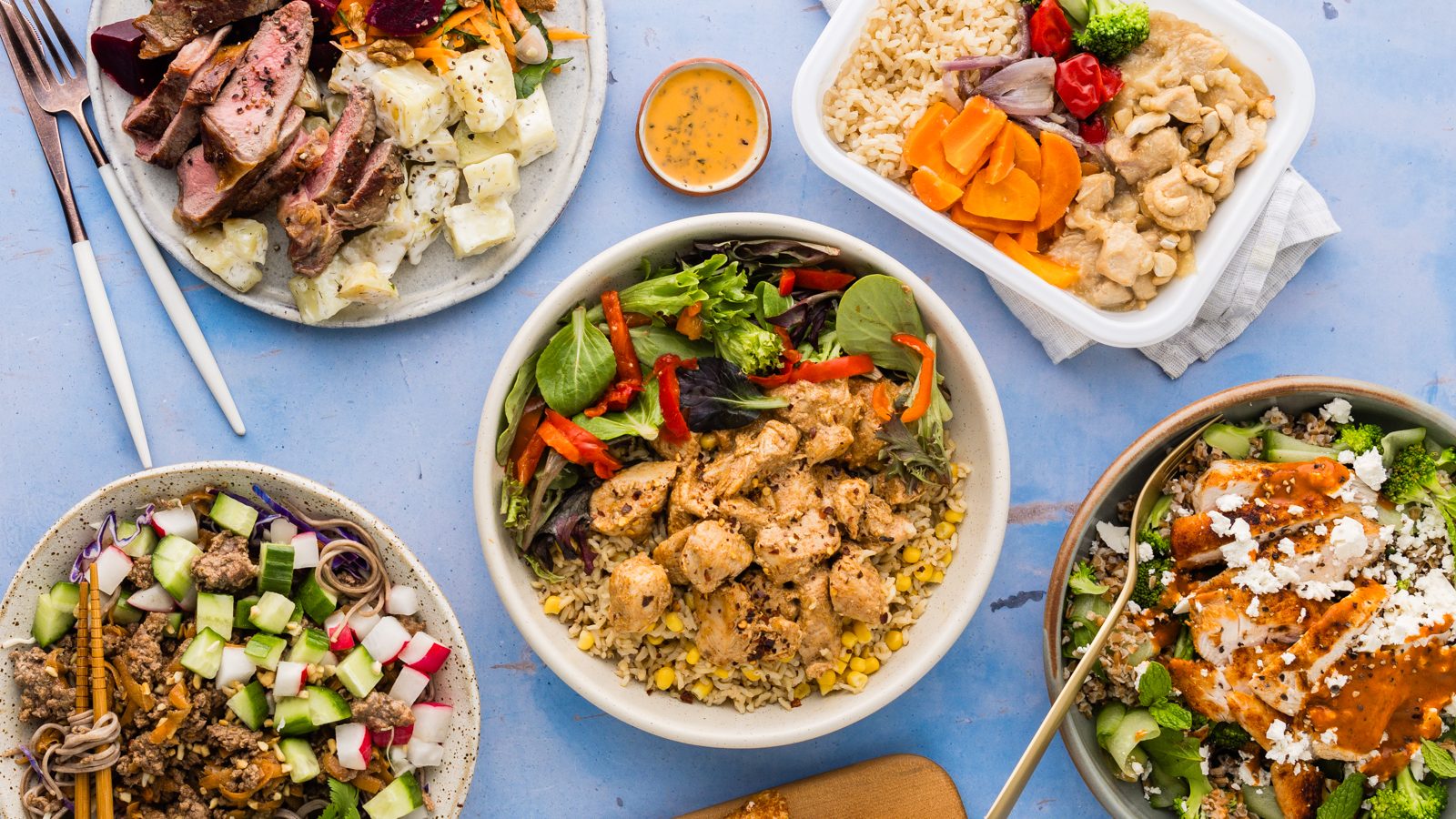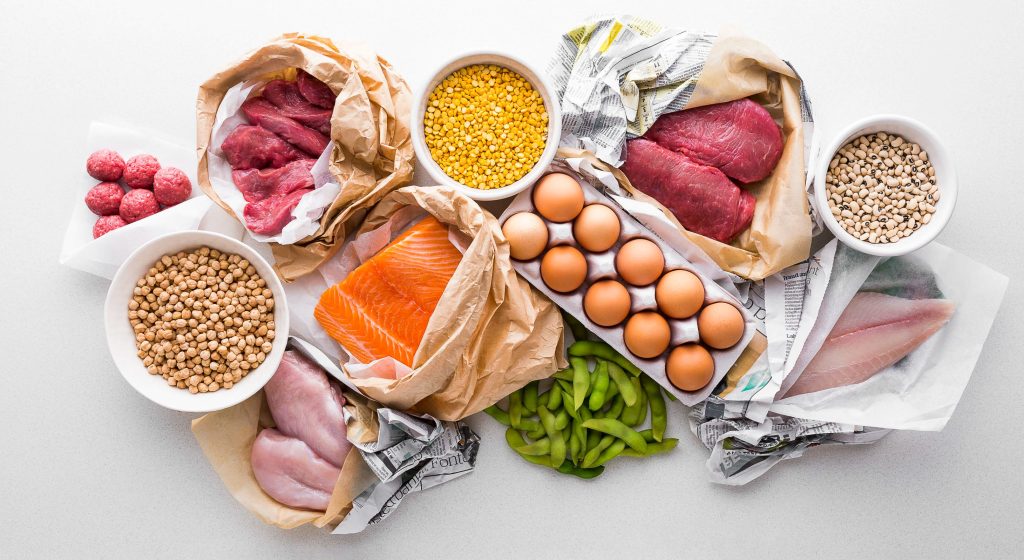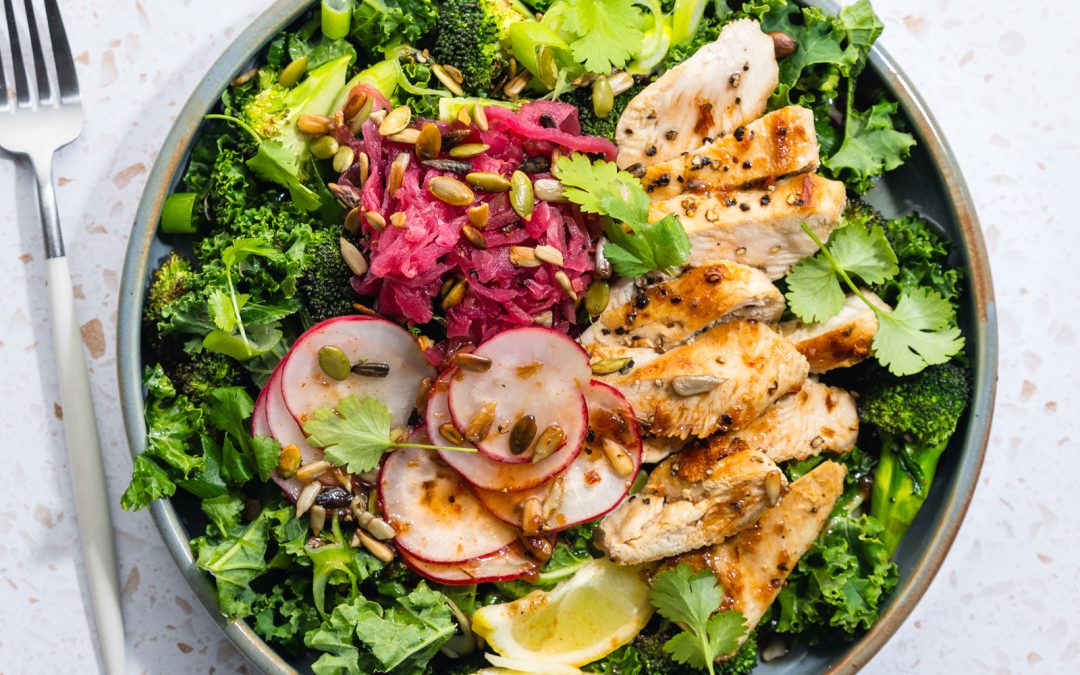
Exercise has many health benefits, but it is equally important to fuel your activity, recovery, repair and growth. Getting the nourishment, you need can help you to feel satisfied and energised throughout the day while reaching your fitness and wellness goals. Protein is integral to muscle growth, bone, ligament and tendon health, body composition and satiety. All whole foods contain some protein—even broccoli and apples have a small amount! But foods that are high in protein are meat, fish, seafood, eggs, dairy (such as milk, yoghurt, cheese), tofu, tempeh, legumes and beans, lentils, and chickpeas.
Protein 101
When we think of nutrients, we often think of vitamins and minerals like vitamin C or iron (which are essential micronutrients that we need in small amounts to help in thousands of physiological pathways in the body), overlooking that protein is an important nutrient too. Protein is a macronutrient, meaning it is a nutrient we need in large amounts.
In addition to being a source of calories (for every gram of protein you eat, there are about 4 calories), protein’s primary role in the body is growth and repair. Protein is broken down in digestion into amino acids—building blocks—that help form and repair muscles, hair, nails, skin, bones, organs, neurotransmitters and hormones. Protein is made up of 20 amino acids. While all 20 are important for your health, nine are classified as essential and 11 as non-essential. In nutrition, ‘essential’ means that we cannot produce it ourselves—therefore, it must be provided in the diet.
What’s the deal with plant-based vs. animal proteins?
Animal foods and soybeans provide all nine essential amino acids in sufficient quantities and are classified as complete proteins. Other plant-based protein sources lack one or more essential amino acids and are called incomplete proteins. People who follow a plant-based diet should eat a variety of plant sources of protein every day (e.g. legumes, nuts, seeds, whole grains) to get all the essential amino acids (1).
People eating plant-based should also consider the “bioavailability” of plant proteins—this means how much of the protein can be absorbed and used by our bodies after we eat it. Whilst it is possible to get enough protein through a well-planned plant-based diet, the protein in animal foods such as dairy, meat, fish and eggs has been shown to be more bioavailable to our bodies (2).
Below are our top three reasons to focus on protein.
1. Supports lean mass, muscle repair and growth
If you’re physically active, lifting weights, or trying to gain muscle, you need to ensure adequate calories and protein to repair and grow the muscle tissue (3,4). Protein helps you maintain your lean muscle mass, and having adequate muscle mass is essential in maintaining your metabolism and health.
Protein intake is often skewed toward the evening meal, whereas breakfast is typically low in protein. Some research shows that the consumption of a targeted amount of protein distributed evenly at each breakfast, lunch, and dinner may be more beneficial in supporting muscle growth (5).
2. Protects tendons and ligaments and is essential to bone health.
Protein in your diet allows your body to make collagen and elastin to keep your tendons and ligaments strong. High-protein foods that nurture collagen production include fish, poultry, meat, eggs, dairy, legumes, and soy (6).
Our bones are ~30% protein. People who eat more protein tend to maintain bone mass better as they age, and there is an association between higher protein intake and better bone mineral density (7). Considering bone health is especially important for women to help prevent osteoporosis after menopause (8).
3. Promotes satiety
Protein distributed evenly can also help with reducing overall appetite and therefore healthier eating. For example, in one study, those who consumed lower amounts of protein in their first meal of the day increased their overall food intake in subsequent meals. In contrast, those who received the recommended amount of protein ate less in following meals (9).

What are some practical, everyday steps to get enough protein?
Start by working out your recommended daily intake (RDI) of protein. The basic calculation commonly used is multiplying kg of body weight by 0.8g of protein. This amount is established to be a minimum level to avoid deficiency. However, many registered dietitians and nutritionist will recommend a higher protein diet when trying to gain muscle— this could be as much as 1.2–1.6g per kilogram (10). For example, an 70kg person aiming to build muscle may have a protein goal of 84-112g per day.
Once you’ve decided on your protein goal, distribute the minimum amount between the number of meals you like to eat, especially the day’s first meal. Try incorporating protein-rich foods such as meat, fish, seafood, eggs, yoghurt, cheese (especially low-fat cottage cheese), tofu, tempeh, legumes and beans, lentils, and chickpeas. For example, a 100g serving of raw/uncooked chicken breast provides 31g of protein. See how you feel. Some people, such as teenagers, pregnant or breastfeeding women, people with illness, athletes, gym goers, and older adults, require more protein to thrive.
Fresh Start has you covered for dinner with our high protein meals containing more than 40g per serve with plenty of fibre-rich veggies.
In summary, the core idea is to eat your daily protein requirements, thereby protecting your lean mass and supporting muscle growth. Targeting a specified gram amount of protein in each meal will help you increase the proportion of protein in your diet.
Can too much protein be harmful?
As with most things, there can be too much of a good thing and if you eat too much protein from red meat, processed meats and animal products it may add higher amounts of saturated fat to your diet and increase the risk of heart disease and bowel cancer. It’s important to eat protein within the context of an overall healthy diet.
The bottom line:
A key part of a healthy diet is to eat your daily protein requirements, thereby protecting your lean mass and supporting muscle growth. Targeting a specified gram amount of protein in each meal will help you increase the proportion of protein in your diet.
Explore some of our protein-packed breakfast and lunch ideas to help you reach protein goals earlier in the day:
Spiced Greek Beef Chickpea Bowl
Brown Rice Veggie Bowl with Smoked Salmon
REFERENCES
- https://nutritionfoundation.org.nz/nutrition-facts/nutrients/protein/
- Gertjan Schaafsma, The Protein Digestibility–Corrected Amino Acid Score, The Journal of Nutrition, Volume 130, Issue 7, July 2000, Pages 1865S–1867S, https://doi.org/10.1093/jn/130.7.1865S
- Kreider RB, Campbell B. Protein for exercise and recovery. Phys Sportsmed. 2009 Jun;37(2):13-21. doi: 10.3810/psm.2009.06.1705. PMID: 20048505.
- Stokes, T.; Hector, A.J.; Morton, R.W.; McGlory, C.; Phillips, S.M. Recent Perspectives Regarding the Role of Dietary Protein for the Promotion of Muscle Hypertrophy with Resistance Exercise Training. Nutrients 2018, 10, 180. https://doi.org/10.3390/nu10020180
- Mamerow MM, Mettler JA, English KL, Casperson SL, Arentson-Lantz E, Sheffield-Moore M, Layman DK, Paddon-Jones D. Dietary protein distribution positively influences 24-h muscle protein synthesis in healthy adults. J Nutr. 2014 Jun;144(6):876-80. doi: 10.3945/jn.113.185280. Epub 2014 Jan 29. PMID: 24477298; PMCID: PMC4018950.
- Harvard Public School of Health
- Groenendijk I, den Boeft L, van Loon LJC, de Groot LCPGM. High Versus low Dietary Protein Intake and Bone Health in Older Adults: a Systematic Review and Meta-Analysis. Comput Struct Biotechnol J. 2019 Jul 22;17:1101-1112. doi: 10.1016/j.csbj.2019.07.005. PMID: 31462966; PMCID: PMC6704341.
- Rizzoli R, Bischoff-Ferrari H, Dawson-Hughes B, Weaver C. Nutrition and bone health in women after the menopause. Womens Health (Lond). 2014 Nov;10(6):599-608. doi: 10.2217/whe.14.40. PMID: 25482487.
- Grech, A, Sui, Z, Rangan, A, Simpson, SJ, Coogan, SCP, Raubenheimer, D. Macronutrient (im)balance drives energy intake in an obesogenic food environment: An ecological analysis. Obesity (Silver Spring). 2022; 30( 11): 2156- 2166. doi:10.1002/oby.23578
- Phillips SM, Chevalier S, Leidy HJ. Protein “requirements” beyond the RDA: implications for optimising health. Appl Physiol Nutr Metab. 2016 May;41(5):565-72. doi:10.1139/apnm-2015-0550. Epub 2016 Feb 9. Erratum in: Appl Physiol Nutr Metab. 2022 May;47(5):615. PMID: 26960445.


